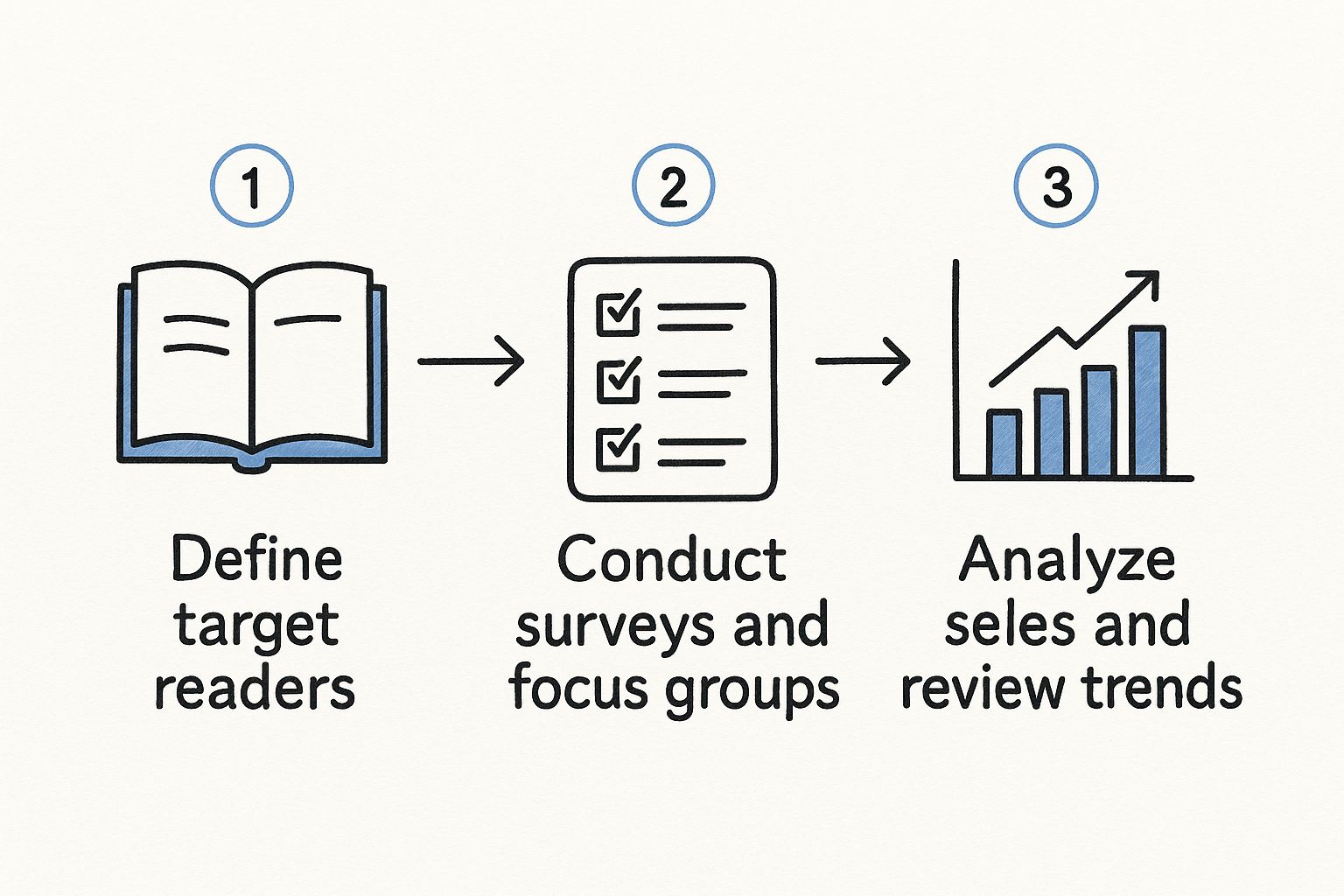Book Market Research Tips for Publishing Success

Why Most Authors Get Market Research Completely Wrong
Let’s get real for a minute. For many authors, the term “book market research” conjures images of tedious spreadsheets and endless scrolling through Amazon bestseller lists. It feels like a chore, another box to tick on a massive pre-launch checklist. This mindset is precisely why most research efforts don't produce meaningful results. Authors often start with preconceived notions, turning a powerful strategic tool into a frustrating exercise that just fuels their anxiety.
The problem starts with a misunderstanding of the goal itself. Good research isn't about finding a magic formula or proving what you already think is true. It’s an investigation to uncover what you don’t know about reader desires, market gaps, and your competition's blind spots. When authors miss this, they stumble into some very common and predictable traps.
Chasing Ghosts and Yesterday's Gold
One of the biggest mistakes is chasing trends that have already hit their peak. An author might see vampire romance or dystopian YA dominating the charts and think, "That's it! That's my ticket." The trouble is, by the time a trend is big enough to be obvious, the market is already flooded. Those successful books you're seeing today were likely written 18-24 months ago when the trend was just starting to bubble up. Writing for a saturated market is like showing up to a gold rush after all the best spots have been claimed—you’re just too late.
Likewise, relying only on high-level bestseller lists gives you a warped view of reality. These lists feature the absolute titans of the industry, often authors with huge followings and massive marketing budgets. Your real goal isn't to go head-to-head with Stephen King or Brené Brown right out of the gate. Instead, your book market research should focus on understanding the "mid-list" successes in your specific niche. Who is consistently selling well without a million-dollar launch? What can their covers, blurbs, and keywords teach you about what connects with your future readers?
The Pitfall of Perfect Data
On the flip side of chasing trends is the trap of analysis paralysis. This is what happens when you get so bogged down in collecting data that you never actually make a decision. You might create dozens of reader personas, track hundreds of competing books, and find yourself drowning in so much information that you can't see the way forward. Research is meant to be a map for navigating, not the final destination. Its job is to reduce uncertainty, not remove it entirely.
To give you some perspective, let's look at the bigger picture of the book market. The following table breaks down some of the key segments, showing just how diverse the industry is.
| Book Market Segments and Growth Patterns |
|---|
| Comparison of different book market segments showing market size, growth rates, and key characteristics |
| Market Segment |
| Current Size (Approx.) |
| Growth Rate (Annual) |
| Key Drivers |
| Print Books (Trade) |
| ~$65 Billion |
| 1-2% |
| "BookTok" trends, collector's editions, desire for physical media |
| Ebooks |
| ~$17 Billion |
| 3-4% |
| Convenience, accessibility on multiple devices, lower price point |
| Audiobooks |
| ~$5 Billion |
| 15-20% |
| Multitasking (commuting, exercise), subscription models, celebrity narrators |
| Educational & Academic |
| ~$7 Billion |
| 2-3% |
| Digital learning platforms, lifelong learning trends, institutional requirements |
This data shows you're stepping into a massive and active marketplace. The global book market is a powerhouse, projected to reach USD 94.94 billion in revenue by 2025 and is on track to surpass USD 100 billion by 2030. You can find more details on these global book market projections to see the trends for yourself.
The sheer scale can be daunting, but it also means there are countless niches and opportunities waiting to be discovered. The secret is to shift your mindset. Stop using research to validate what you want to write and start treating it as a strategic exploration to find where your unique story can truly thrive.
Making Sense of Conflicting Industry Reports
If you’ve ever dipped your toes into formal book market research, you’ve probably felt a bit of whiplash. One report claims the global book market is skyrocketing, while another shows a much more conservative number. It’s easy to throw your hands up and call it all noise, but the inconsistencies you're seeing are a normal, if confusing, part of the process. The secret is knowing why it happens so you can pull out the information that actually helps you.

The different numbers almost always come down to methodology and scope. I like to think of it like two photographers taking a picture of the same elephant. One is up close, capturing the detailed texture of its skin (a narrow, deep analysis). The other is standing way back, getting the entire animal in its habitat (a broad, high-level view). Neither photo is "wrong," but they tell completely different stories.
Deconstructing the Data: What to Look For
When you run into reports that don't match up, it’s time to put on your detective hat. Don’t just glance at the headline figures; you need to dig into the "how." These are the usual suspects behind conflicting data:
- Scope and Segments Included: Does the report only cover traditional trade publishing, or does it also bring in academic, professional, and educational books? Are self-published titles part of the equation? Does it include ebooks and audiobooks, or just print? A report zeroed in on the U.S. print market will naturally look tiny compared to one analyzing the global digital-plus-print world.
- Data Collection Methods: How did they get their information? Some reports use sales data straight from publishers, which is usually accurate but often misses the huge indie author market. Others might use consumer surveys, which can show different buying habits but might be skewed depending on who they asked.
- Timeframe and Projections: Always check the years being analyzed. A report from 2022 will paint a different picture than one from 2024. Also, remember that future projections (like the CAGR, or Compound Annual Growth Rate) are just educated guesses based on different economic models and assumptions.
A Real-World Example of Market Variance
These aren't small differences; we're talking about discrepancies worth tens of billions of dollars. For instance, recent market research shows some major differences in how the global book market is valued. One analysis sized the books market at USD 156.43 billion in 2024 with a forecasted CAGR of 3%, while another source estimated the 2025 market at a much lower USD 120.88 billion. You can discover more about how these book market reports are compiled to see the methodologies for yourself.
Your goal isn't to find the one "true" number. Instead, your job is to find the report whose methods best match your book's specific situation. If you're an indie author planning to release a sci-fi ebook, a report weighted heavily toward traditional print textbook sales is far less useful than one that dives deep into digital genre fiction trends. By understanding what’s really being measured, you can pull out the insights that matter for your publishing strategy and move forward with confidence.
Where the Real Money Is Moving in Digital Publishing
When authors think about digital publishing, it’s easy to let your mind jump straight to Kindle ebooks. And while that’s a massive piece of the publishing pie, focusing only on traditional ebooks is like watching the stock market and only paying attention to one company. The real opportunities—where the smart money is flowing—are often tucked away in less obvious corners. Effective book market research today isn't just about what's topping the charts on Amazon; it's about spotting where reader attention and money are quietly shifting.
One of the biggest moves we’ve seen is the explosion of audiobooks. This isn't a niche market anymore; it's a full-blown mainstream format experiencing incredible growth. People are listening to books while commuting, working out, or doing chores, effectively turning their downtime into story time. This has created a huge appetite not just for big-name narrators but for specific genre content. For example, cozy mystery and epic fantasy audiobooks are doing exceptionally well because their fan bases love long, immersive listening sessions.
The Rise of Subscription and Serialized Content
Beyond one-off sales, another major trend is the shift to subscription models. Platforms like Scribd, Kobo Plus, and even more specialized apps such as Radish or Wattpad have built audiences who prefer paying a flat monthly fee for unlimited reading. For an author, this can mean a more predictable income stream. Instead of relying on the highs of a new release, you can earn consistently from a back catalog that new readers are always discovering.
This model flips the economics on its head. You might find that your per-book royalty is lower on a subscription service, but the sheer volume of "pages read" or "minutes listened" by a much larger audience can lead to significantly higher earnings overall. It’s a game of volume and steady discovery, not just launch-week sales.
To put these shifts into perspective, let's compare the different channels where books are sold today. This table breaks down the key performance indicators for digital versus traditional publishing routes.
| Channel Type | Market Share | Revenue Growth | Audience Reach | Entry Barriers |
|---|---|---|---|---|
| Digital/Online | ~25% and Growing | High (7.1% CAGR) | Global, 24/7 Access | Low (Self-publishing) |
| Physical Retail | ~50% (Stable/Slight Decline) | Low to Moderate | Local/Regional | High (Gatekeepers) |
| Audiobooks | ~10% and Rapidly Growing | Very High (20-25% CAGR) | Global, Mobile-First | Moderate (Production Costs) |
| Subscription Services | ~5% and Growing | High | Niche but Loyal | Low to Moderate |
As the table shows, while physical retail still holds a large market share, the momentum and growth are squarely in digital channels, especially audiobooks and online retail. This data reinforces the need to look beyond the bookstore shelf.
Following the Digital Trail
Understanding these changes means taking a wider view of your market research. You need to look past simple sales ranks and start analyzing where digital reading habits are headed. The data paints a clear picture: a powerful and sustained move toward online channels. This chart from Precedence Research shows just how strong the growth outlook is for online books.

This graph isn't just showing a small bump; it's forecasting a market that will nearly double in less than a decade. The online book segment is what’s driving much of the industry's overall expansion. Estimates place the global online books market at USD 26.04 billion in 2025, with projections showing it will climb to around USD 48.27 billion by 2034. That's a compound annual growth rate (CAGR) of 7.1%, which is incredibly strong. You can explore more online book market data to see the full picture of this trend.
The bottom line is that the digital market is becoming more diverse. Your research must factor in these emerging channels. Are there popular subscription platforms for your target readers? Is your genre a good fit for being released in a serialized format on an app? Answering these questions can help you find untapped revenue streams and put your work exactly where readers are spending their time and money.
Research Tools That Actually Save You Time and Money
Alright, let's get practical. The world of book market research can feel like it's full of expensive, complicated tools promising to unlock all of Amazon’s secrets. But great research isn’t about having the fanciest dashboard; it’s about using the right tools—many of them free—to get specific answers without draining your wallet. The goal is to build a simple, effective toolkit that actually works for you.
To make things clearer, this infographic breaks down the core flow of any solid research plan: figuring out who your audience is, gathering their direct feedback, and then analyzing the broader market data.

This visual shows that successful research is a sequence of focused actions, not just a random dive into data. It always starts with people, moves to direct questions, and ends with market validation.
Your Go-To Free Research Toolkit
Before you even think about pulling out your credit card, let’s talk about the powerhouse tools you can use for free. My absolute favorite place to begin is Google Trends. It's brilliant for seeing how much public interest there is in your book's main concepts, themes, or even potential titles over time. For instance, if you're writing historical fiction set in the Gilded Age, you could compare search interest for "Gilded Age" versus "Victorian era" to see which term connects better with a general audience right now.
This screenshot from Google Trends compares search interest for two popular fantasy tropes, "enemies to lovers" versus "found family," over the last year.

As you can see, "enemies to lovers" consistently has higher search volume, but both tropes have clear peaks. These spikes could line up with big book releases or TV shows, giving you a goldmine of insight into reader appetite for specific elements in your genre.
Another priceless—and free—method is to directly analyze reader communities. Spend some time in Goodreads groups, Subreddits (like r/fantasy or r/romancebooks), and Facebook groups dedicated to your genre. Don't just lurk; pay close attention to the language readers use. How do they talk about the books they love and the ones they hate? What specific plot points or character types get them fired up? This is raw, unfiltered consumer insight.
Smart Investments: When to Pay for Data
While free tools are fantastic, there are times when you need more specialized data. This is where professional tools can be a worthy investment, but you have to be smart about it. Instead of locking yourself into a pricey annual plan, check if a tool offers a one-month subscription. You can often get all the intensive research you need for a launch done in that single month. Tools that pull together Amazon sales data and keyword performance are especially helpful for dialing in your KDP categories and keyword strategy.
For publishers managing many titles, a more structured system is often needed. If you want to make the research process more efficient across a large catalog, looking into dedicated publisher services can give you the scale you need to handle marketing reports for lots of books at once.
Of course, collecting all this information—from forum comments to trend reports—can get messy. To make sense of it all, you might consider using more advanced tools to organize the data you gather. Many authors find that using AI note-taking apps helps them synthesize notes and spot patterns quickly. In the end, the best tool is the one that gives you actionable insights to position your book for success, whether it costs you nothing or is a strategic monthly expense.
Finding Your People in a Crowded Market
Effective book market research isn't about casting the widest net possible; it's about being incredibly specific. Simply targeting "women, aged 35-55" isn't enough to stand out anymore. To truly connect with readers, you have to dig into their psychology and habits. What makes them pick up one book over another? This involves moving past generic personas and building a genuine understanding of your reader's world. A great way to start is by using an ultimate target audience analysis template, which can guide you to think about psychographics—their values, attitudes, and lifestyles—not just their age or where they live.
Uncovering Reader Motivations
Want to know what readers really think? Go straight to the reviews. Don't just glance at the star ratings on Amazon or Goodreads. The real insights are buried in the text of the 3- and 4-star reviews for books similar to yours. A 5-star review might just say, "Loved it!" but a 4-star review often explains why it wasn't perfect: "The world-building was fantastic, but the main character felt a little too passive." That's pure gold for an author. You're learning what readers in your genre truly care about and where their expectations are falling short.
This is a powerful, organic way to conduct market research. For instance, if you see a pattern of thriller readers complaining about predictable twists, you've found a market gap. You can then position your book as the one that delivers the shocking, unforeseen ending they're craving. That’s much more compelling than just calling it a "fast-paced thriller."
You can also see these preferences reflected on a larger scale by checking out bestseller lists. The Amazon Charts, for example, show what’s currently resonating with a huge audience.

This snapshot of the most-sold fiction highlights a strong reader appetite for specific subgenres, from romantic fantasies to domestic thrillers. It shows the power of blending established genres to meet what readers are actually buying.
Identifying Underserved Niches
Identifying your audience also means spotting who is being left out. Consider the "romantasy" phenomenon, a blend of romance and fantasy. For years, these genres were mostly separate. But clever authors noticed a massive crossover audience—fantasy fans who wanted more romance and romance fans who craved deeper world-building. By targeting this underserved niche, authors ignited one of the most explosive categories in modern publishing. This wasn't a fluke; it came from listening to what readers were asking for in forums, book clubs, and reviews.
The goal is to find the intersection between what you love to write and what a dedicated group of readers is desperately seeking. If you'd like a more detailed walkthrough, our guide on how to master target audience identification for authors can help. This level of precision is what turns a one-time buyer into a lifelong fan who tells everyone they know about your books.
Learning From Your Competition Without Copying Them
When you hear "competitive analysis," what comes to mind? For many authors, it's a quick peek at the top ten bestsellers in their genre to see what cover art is trending. But this kind of surface-level glance is a missed opportunity. Real analysis isn’t about copying what's popular; it's about understanding why certain books and authors succeed so you can carve out your own unique space.
Your top competitors are more than just their book pages. They're running small businesses. You need to look at their entire operation to get the full picture.
- Beyond the Book: Are they active on a blog, podcast, or YouTube channel? Notice the topics they discuss. This is how they attract readers before they even think about buying a book.
- Pricing Strategy: Do they ever discount their older books or offer the first book in a series for free? These aren't random sales. They are calculated moves to acquire new readers, and tracking them can reveal a lot about their business model.
- Reader Interaction: How do they talk to their fans on social media or in their newsletters? Pay attention to the questions they ask and what type of content gets the most authentic engagement. This is a direct line into what your shared audience really cares about.
Deconstructing Competitor Reviews
One of the richest sources of market intelligence is hiding in plain sight: reader reviews. The gold isn't in the five-star gushing; it’s buried in the three- and four-star comments. These reviews are where readers offer up incredibly specific feedback. You might find a comment like, "I loved the magical system, but the romance felt rushed." That's a clear signal for an unmet need in the market.
Platforms like Goodreads are absolute treasure troves for this kind of information. By digging into the discussions around books similar to yours, you start to absorb the language, tropes, and expectations of your ideal readers.
For example, look at a popular book's Goodreads page. The sheer volume of ratings and reviews tells you there's a passionate readership. The "Want to Read" numbers can also give you clues about what marketing efforts are building pre-publication buzz.
Identifying Market Gaps
As you systematically track your competition, you'll start to see patterns—not just in what they do well, but also in where they fall short. These weaknesses are your openings. Maybe you notice that several big names in your sci-fi subgenre write fantastic, action-heavy plots but consistently get dinged in reviews for shallow character development. That's a market gap.
This insight allows you to position your book as a character-driven sci-fi novel that delivers the emotional depth readers are craving. You can meet the genre expectations for action while filling a void that the top players are ignoring.
This approach changes your entire mindset. You stop being a follower and start being a problem-solver. You're not just writing another book; you're creating a better reading experience for a specific audience. This is how you learn from the competition to build something new and find a loyal readership that's all your own.
Turning Insights Into Publishing Gold
All the book market research you’ve done is just a pile of interesting facts until you actually use it. Data sitting in a spreadsheet doesn’t sell books—smart decisions do. This is where you connect the dots between analysis and action, turning your new knowledge into real strategies that can make or break your book's launch.
Think of your research findings like ingredients for a cake. You can have the best flour, sugar, and chocolate, but they won't magically become a dessert. Your publishing strategy is the recipe, and your research tells you exactly what to do with those ingredients to bake something amazing.
Developing a Market-Responsive Content Strategy
Your research should be the blueprint for what you write. Let's say your competitive analysis showed that readers in the historical fiction genre are devouring stories about WWII nurses but often complain about historical inaccuracies in those books. That's not just an observation; it's a golden opportunity.
Your content strategy is now crystal clear: write a meticulously researched novel about a WWII nurse. Then, when you market it, you can specifically highlight its historical accuracy to attract those very readers who are looking for it. You're filling a specific gap you found in the market. To really get to the bottom of these trends, using qualitative data analysis techniques is a game-changer. It helps you understand the why behind reader preferences, tapping into the emotional triggers that make them buy one book over another.
Creating Laser-Focused Marketing Campaigns
Throwing generic ads out into the world is like shouting into the void—a waste of time and money. Your research gives you the power to be incredibly specific. Instead of running an ad that targets "thriller readers," your insights might point you to "fans of psychological thrillers with unreliable narrators who also listen to true crime podcasts." See the difference?
This level of detail helps you build a profile of your ideal reader. You’ll know things like:
- Their online hangouts: Are they active in niche Facebook groups, certain Subreddits, or following specific #BookTok trends?
- Their trusted sources: Do they follow particular book bloggers or listen to specific podcasts for recommendations?
- Their trigger words: What phrases in a book description make them hit "buy" without a second thought? Think "slow-burn romance," "mind-bending twist," or "found family."
With this knowledge, you can write ad copy, create social media posts, and design email campaigns that speak directly to what they want. This approach is at the heart of all the best book marketing strategies; they're built on deeply understanding a specific audience. It not only boosts your conversion rates but also builds a loyal fanbase because readers feel like you "get" them.
Building Systems for Ongoing Success
Great research isn't a one-and-done project. It's a continuous process that keeps you ahead of the curve. You need to build a simple system to keep an eye on the market. This doesn't have to be some complex, time-consuming task.
It can be as straightforward as setting up Google Alerts for your top competitor authors or spending 30 minutes each week browsing the "also-boughts" on your book's Amazon page. The goal is to stay agile and informed. By keeping a pulse on the market, you can spot new trends as they pop up, adjust your pricing or keyword strategy based on what's currently working, and make better decisions for your next book. This turns your research from a pre-launch chore into a lasting competitive advantage.
Tired of guesswork? ManuscriptReport.com can turn your manuscript into a complete, data-driven marketing blueprint in about 10 minutes. Get everything from KDP categories and keywords to blurbs and ad copy, so you can spend less time on research and more time writing. Get your instant book marketing report today!
Related Articles

How Self-Publishing Will Evolve in 2025: Key Insights Inspired by Julie Broad of Book Launchers
Explore the future of self-publishing in 2025 with insights from Julie Broad of Book Launchers, covering AI tools, data-driven decisions, video promotion, and audiobook trends.

Research Comparable Titles for Your Book Easily
Learn how to find comparable titles for your self-published book quickly and effectively.